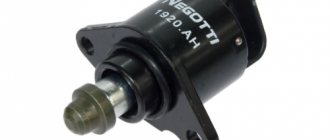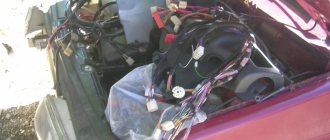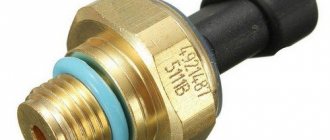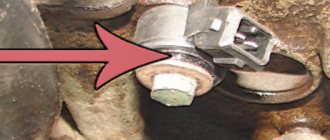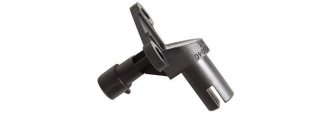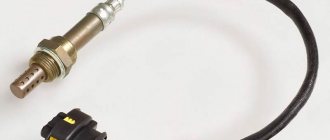This article describes all injector sensors on VAZ family cars. The article is generalized, since all sensors installed on cars of the Volzhsky Automobile Plant are identical to each other and even interchangeable.
After studying the article, you can easily determine the location of the sensor, understand its symptoms of malfunction, and also learn about its purpose. This material only talks about sensors on fuel-injected cars, since there are negligible numbers of engine control sensors in carburetor versions, and besides, there are fewer and fewer carburetor cars.
The engine control unit
All injection Ladas have a special unit that reads and processes readings from all sensors in the car system. This block is a small part made of plastic and metal, inside of which there is a microcircuit with many radio components. It is this block that sends signals to the fuel pump, injectors and ignition module, and also forms the ignition timing, controls the operation of fans, etc. This is a kind of car head unit.
Location
In all Lada models it is located in the cabin, in classic Lada models it is located under the glove box, in front-wheel drive Ladas the ECU is located under the center console. The location of the ECU can be called a problematic place in Lada Granta and Kalina cars, since the ECU is located under the heater radiator, which quite often exposes it to getting wet with antifreeze and disabling it. Many owners of these cars move the ECU under the glove box.
Symptoms of a problem
The unit does not have a malfunction as such; its failure may be associated with the failure of any of the sensors. For example, if one of the cylinders fails, the problem may lie not in the ignition module or coil, but in the key located in the ECU. Often a radio component that burns out inside the unit can affect the operation of any of the sensors.
Crankshaft position sensor
Installed on all Lada cars with an injection engine, it serves to determine the top dead center of the piston. Based on its readings, the engine control unit reads readings about the position of the pistons in the engine. After receiving the data, the ECU sends signals to the ignition module and injectors to supply a spark and fuel at the right time and into the right combustion chamber of a certain cylinder.
The sensor operates on the principle of electromagnetic induction. It itself is made of plastic, inside of which there is a magnet with a winding. A drive disk (crankshaft pulley) rotates next to the sensor, from which the sensor reads readings. There is a special slot on the pulley, the so-called “caries”, this slot makes it clear to the sensor what position the pistons and crankshaft are currently in.
Location
The sensor is located on all Frets in one place, near the generator drive pulley, this part is attached via a bolt. On the oil pump body there is a special cast bracket in the form of an ear; the sensor is inserted into it and secured with an M6 bolt.
Symptoms of a problem
If the crankshaft sensor fails, the car will not start due to a missing spark and injectors not working. Loss of communication with the sensor blocks the operation of the ignition module and injectors, causing fuel to enter the oil, etc. Also, if the sensor breaks down, the engine may start to stall, but this only happens when the sensor has not yet completely failed.
VAZ speed sensor pinout and DS connection diagram
The speed sensor is an element of the vehicle's electronic control system.
It depends on its readings how much fuel will be supplied, how much air will bypass the throttle valve when idling, and what the speedometer readings will be. The speed sensor of a VAZ car is based on the use of the Hall effect, that is, a stream of pulses is transmitted from the device to the car's ECU, the frequency of which is proportional to the speed of the car. Auto electronics, analyzing incoming data, selects the required idle speed and sends a signal to a device that regulates the engine idle speed, which optimizes the composition of the air-droplet mixture entering the combustion chamber, bypassing the throttle valve.
During a distance of one kilometer, the speed sensor transmits over 6000 pulses to the ECU. Based on the parameters of the time analysis of inter-pulse signals, the on-board computer transmits data to the dashboard, thereby determining the speedometer readings.
As in many other cars, the VAZ speed sensor is located in the upper part of the gearbox housing, not far from the engine oil level dipstick. You can get to it from two sides: from above, by opening the hood and disconnecting the adsorber, and from below, using the inspection hole for convenience.
Knock sensor
With the advent of injection engines in Lada, regulation of the ignition timing angle (IAP) went into oblivion. This task began to be performed automatically, but as is known, the quality of the fuel also affects ignition, therefore, in order to avoid large detonations in the engine when using low-quality fuel, a knock sensor was used, which detects the slightest detonations in the engine and transmits the readings to the ECU, which in turn, changes the OZ to ensure normal engine operation.
The DD is a round part with a hole inside for attaching it to the engine body. It works similar to a piezoelectric element, that is, when struck, it produces a small electrical voltage. When detonations occur in the engine, the sensor detects them and transmits voltage pulses to the engine control unit to adjust the SOP.
Location
On all Lada models, regardless of the drive type, this part is located on the engine block and secured with a bolt. There are also sensors that themselves have a thread and are screwed into the body of the cylinder block. More precise location of the sensor in the center between cylinders 2 and 3.
Symptoms of a problem
If the sensor breaks down, the engine begins to operate in emergency mode, that is, the ECU can no longer adjust the OZ, and if you refuel with low-quality fuel, then an unpleasant knocking sound appears on the car, and its operation becomes uneven and rough, vibrations appear at idle and consumption increases fuel.
Causes of VAZ 2107 injector malfunctions
The VAZ 2107 injector has a number of advantages, but also several significant disadvantages that you should know about in advance. If you have this car model at your disposal, it is worth familiarizing yourself with the maintenance features of its injection system. But first we need to discuss the design of the VAZ fuel system.
Injector purpose
Installing an injector in the VAZ 2107 made it possible to significantly improve engine performance. Changing the type of fuel system increases the amount of energy that is produced during the combustion of gasoline. Compared to a carburetor engine, a fuel injection system is more efficient in the initial stages, but over time its performance decreases. What does this depend on?
VAZ 2107 injector plays the role of the final element in the fuel system of the car. The air mixture, together with a cloud of atomized gasoline, creates a huge amount of energy. Over time, this atomization may become less effective, the fuel jets will become weaker, and all due to low-quality gasoline.
The main cause of injector failure is poor fuel. Car fuel consists of many chemical components; in addition, various impurities are added to it, which should improve the overall performance of the engine. This factor cannot be ignored, since such gasoline leaves sediment on the walls of the fuel system. The thinnest channels are in the injectors, and it is these devices that suffer first. VAZ 21074 injector has the same problem. During operation, deposits from fuel only accumulate. What needs to be done to stop this?
Cleaning and preventing plaque in the system
The injector device is very sensitive to large inclusions in gasoline. If you are using a cheap brand of fuel, be prepared to change your injectors soon. So the first thing you should do for your VAZ fuel pump is change the brand of fuel. The power supply system of the VAZ 2107 should become cleaner; the possibility of plaque formation in the system is still not excluded. Since the flammable liquid in the channels occasionally stagnates and sometimes even freezes, an early breakdown can be prevented only in one way - regular cleaning.
Approximately every 35-40 thousand km it is necessary to carry out preventive cleaning work on the fuel system. You need to wash the channels with your own hands. The performance of the engine will depend on the quality of cleaning. If this procedure is carried out irregularly, then soon you can say goodbye to one injector and look for a new one, and then you will have to change the remaining elements of the VAZ fuel pump.
In 4-cylinder types of injection engines, different intensities of injector clogging are observed. The temperature in the area of cylinders 2 and 3 is always elevated, so sediment accumulation occurs there faster.
A special admixture of polyetheramine is considered a prophylactic agent in such cases. It prevents the accumulation of burning for a long time.
Damage diagnostics
How to understand that an injector needs to be replaced, checked or repaired? Even without sensors, you can understand that repair of fuel system elements is required if there are 1 of 2 main signs in models 2107, 21074:
- Unstable engine operation. Sometimes it may stall or have difficulty starting.
- A much less obvious sign is loss of power. This effect is noticeable if you mostly drive at medium speeds, but at high speeds it is very noticeable.
- The last sign is recorded only by sensors - the pressure inside the system increases.
The cause of such failures is clogged injectors; even diagnostics are not needed. Cleaning helps restore the engine to its original performance. If the problem has not been resolved after cleaning, it is worth checking the tubes and injectors for damage or breakdowns. In such cases, it is better not to start repairs, but simply replace the damaged parts with new ones.
Sometimes it is impossible to determine on your own where the damage is, and only then will diagnostics at service centers come in handy. A blockage can cause quite serious damage to the VAZ 2107 injector, as well as rupture of channels. The pressure that arises inside the system can easily destroy the most fragile parts. Here you won’t be able to fix the situation with your own hands, even if you have a complete diagram of the car at hand. There is only one conclusion - you need to devote a lot of time and attention to cleaning injectors and do it regularly.
Things to take note
To repair the fuel system yourself on a VAZ, you will need to remove the receiver.
This is carried out in several stages:
- First, remove the throttle controls from the receiver, then loosen the retaining clamp and disconnect the vacuum hose.
- The fuel pipe holder is being dismantled.
- The bracket-clamp of the throttle drive cable is removed.
- The 5 fastening nuts are twisted and the pressure adjustment hose is disconnected. After this you will be able to remove the receiver from the studs.
This is the only way to gain access to the fuel rail.
Conclusion on the topic
Model 2107 and VAZ 21074 injector have common problems with the fuel system due to the injection type of fuel atomization. You can clean the channels with your own hands, check for damage and replace parts if necessary.
To find a breakdown in the channels, you will need a diagram of the car, as well as partial dismantling of some components. To keep the injection system in working condition, clean the channels regularly and also add a little special cleaner to the fuel tank.
Coolant temperature sensor
In carburetor Lada models, the coolant temperature sensor was used to turn on the cooling fan, but in the injection version of cars, this DTOZ began to perform several functions. For example, the sensor in modern modes is involved in adjusting the fuel mixture, turning on the fan, and also displays information about the coolant temperature on the dashboard. The fuel mixture is adjusted based on temperature, that is, when the engine is cold, it needs a rich mixture, but when the engine is hot, the mixture needs to be leaner.
Location
The sensor can be found under the car air filter housing; it is located in the thermostat housing and is connected to a connector with two wires. The sensor is screwed in through a threaded connection, and a special O-ring is located between the DTOZH and the thermostat body.
Symptoms of a problem
When the sensor fails, the car experiences increased fuel consumption, as well as a lack of warm-up speed, the engine may begin to have trouble starting. All of these problems indicate a problem with the temperature sensor.
CHECKING THE TEMPERATURE SENSOR VAZ 2107
To carry out the test we will need the following tools:
- household multimeter;
- container with water;
- household boiler;
- thermometer;
- temperature sensor removed from the car.
TEST SEQUENCE
- The sensor is lowered into the prepared container so that its threaded part is completely under water.
- A thermometer and a boiler are lowered into the same container (you need to make sure that these tools do not come into contact with each other).
- The multimeter contacts are connected to the sensor contacts, and the multimeter itself is configured to measure resistance.
- The boiler is plugged in and the water starts heating.
- When the water reaches a temperature of 95 degrees, the sensor resistance shown by the multimeter should disappear. If this happens, the sensor is working. If at the above temperature the resistance on the multimeter does not disappear, the sensor is faulty and needs to be replaced.
VIDEO: CHECKING THE ANTIFREEZE SENSOR
Speed sensor
Older Lada models, such as the VAZ 2108 and Classic, used a mechanical speedometer drive, but with the advent of the injector, more electronics appeared in cars and the mechanical speedometer drive went into oblivion. Currently, an electronic speedometer is used in all Ladas; it is a part that works on the principle of electromagnetic induction, which reads readings from the crankshaft gear and transmits them to the engine control unit. The main task of the speed sensor is to calculate the speed, but in models with electric power steering, the speed sensor affects the operation of the power steering.
Location
The speed sensor is located predictably on the gearbox housing, near the gearbox oil level dipstick. The sensor is attached through a bolted connection, and the tightness is ensured by a special oil-resistant sealing ring.
Symptoms of a problem
If the sensor breaks down, the speedometer stops working or its readings become unreliable. In modifications of cars with electric power steering, if the sensor breaks down, the power steering may stop working.
Replacement
Before repairs, it is necessary to do preparatory work. Firstly, you will need a pit, overpass or lift. Secondly, you will need a tool: a powerful flat-head screwdriver and a 22mm open-end wrench. The sequence for removing the speed sensor on an injection VAZ 2107 is as follows:
- Unscrew the speedometer cable nut and remove it.
- Press the connector lock and disconnect the connection.
- Use a 22 mm wrench to unscrew the sensor itself.
Assembly of the unit is carried out in the reverse order. After replacement, most likely, a check light will light up on the instrument panel. This is a circuit fault. To fix the problem, you need to clear the error through the application.
Mass air flow sensor
All Lada models are equipped with a mass air flow sensor for injectors. It is used to count the air supplied to the car engine. For proper operation of an internal combustion engine, you need not only the presence of fuel, but also air. Fuel must be mixed with gasoline in the right proportions to prepare the correct fuel mixture, this is why a mass air flow sensor is needed, it calculates the amount of air entering the engine and transmits the readings to the ECU. The sensor is quite finicky and if the air filter is not changed in a timely manner, it can quickly fail, and its cost is high.
Location
The sensor can be found on the air filter housing; at the end, the sensor is attached via two bolts, and on the other side, a rubber corrugation is connected to it, which is secured with a large clamp. The MAF has a connector with several wires.
Symptoms of a problem
If the sensor breaks down, the engine starts to run unstably, starting is disrupted, and high fuel consumption occurs. If such malfunctions occur, the sensor can be checked.
Throttle position sensor
TPS is used to determine the opening angle of the valve inside the throttle. Such a sensor was installed only on mechanically driven throttle units; in mid-2012, almost all Lada cars began to be equipped with an electronic throttle, in which TPS was abandoned.
The sensor quite often failed due to its design, since there is a resistor inside it along which tracks run when the throttle is opened; very quickly these tracks became unusable due to rapid erasure and the sensor itself turned out to be inoperative.
Location
The TPS is located on the throttle assembly; it can be detected using a suitable wire. It is secured with two screws, and there is a foam sealing ring between the sensor and the remote control body.
Symptoms of a problem
When the TPS is broken, the speed spontaneously drops and rises in the region of 500-2500 rpm; this problem is quite difficult to confuse; it occurs quite often and this is the most important sign of a TPS malfunction. Also, if it breaks down, unstable operation of the internal combustion engine occurs, idle speed is lost and fuel consumption increases.
Idle speed control
To regulate idle speed on Lada cars, an idle speed regulator (IAC) is used. It is an electric motor operating on direct current and a voltage of 12 V. The IAC has a worm gear, which is very unreliable and often fails. The role of the sensor is to open or close the idle speed channel. The IAC is only involved when the engine is idling and the throttle valve is closed. In modern Ladas, starting from 2012, the sensor was no longer used due to the transition to an electronic throttle unit.
Location
The idle speed control is located on the throttle body and is attached to the body with two screws. Between the regulator and the throttle body there is a rubber sealing ring, which very often wears out and begins to leak air.
Symptoms of a problem
If the sensor breaks down, the idle speed begins to drop to low values until the engine stops. Most often, the IAC becomes contaminated, after which it ceases to perform its functions.
Symptoms of a problem
In most cases, damage to the sensor on the injection VAZ-2107 is indicated by a yellow indicator on the instrument panel. In this case, you can notice that the car has become:
- Unstable operation at idle speed;
- show errors on the speedometer;
- consume more gasoline;
- bad pull.
It is recommended to carry out diagnostics, for example, through an application on a smartphone (ELM327 VAZ for Android), since the listed defects can be caused by problems with other elements of the system.
Oxygen sensor
With the advent of EURO standards, they began to care about emissions into the environment from cars. For this purpose, oxygen sensors (lambda probe) began to be used; it serves to determine the concentration of carbon dioxide in the exhaust gases of a car. If these parameters exceed the permissible values, the sensor sends a signal to the engine control unit to change the proportions of the fuel mixture and reduce harmful emissions into the environment.
Location
Depending on the vehicle configuration and year of manufacture, the number of oxygen sensors may change. Older models use a single oxygen sensor on the exhaust manifold. In cars with a catalyst, two oxygen sensors are used before and after the catalyst.
Symptoms of a problem
When the lambda probe fails, the car begins to consume more fuel, its power and previous dynamics are lost. Quite often, a breakdown in the DC can affect the operation of the entire engine; detonation and strong vibrations may occur at idle.
VAZ sensors - the main sensors on injection VAZ cars
So, dear visitors, today we will tell you about the main sensors on the VAZ. Since the operating principle of injection engines in the AvtoVAZ line is the same, in principle we have put together a manual on the sensors that are installed on injection VAZs by the manufacturer, and have prepared a brief description of the operating principles and purpose of each of the sensors below. Indeed, in essence, the very principle of operation of an injection engine is the interconnected work of the “brains” (ECU) and various kinds of sensors; there is a constant exchange of information between them and, depending on the totality of certain indicators of the sensors, the controller prepares the mixture and ensures stable and correct operation of the engine.
So let's start with the crankshaft position sensor DPKV . (pictured above)
Without this extremely important sensor and if it malfunctions, the car simply will not start. DPKV generates signals to the ECU using a special toothed disk, on which, upon careful examination, you can see what appears to be a “missing” tooth; this disk is installed directly on the crankshaft. DPKV on VAZs is located on the oil pump cover. The sensor is quite reliable and its failure is rare. But nevertheless, if it fails, you will have problems. We recommend carrying it with you in the glove compartment just in case.
Let's move on. Another important sensor is the throttle position sensor TPS .
This sensor works in conjunction with the idle air control valve to determine how open the throttle valve is. If this sensor begins to fail or fails altogether, then we will not see a stable idle and the engine speed will live its own life. Dips may also be felt, the engine will pull jerkily, in general it is not pleasant.
Now we are presented with a phase sensor, or camshaft position sensor DPRV .
It determines the position of the camshaft. Not used on 8 valve engines of early injection VAZs. Participates in the formation of phased injection, that is, the desired injector of a particular cylinder works at the right moment. If the sensor is faulty, then the system works as if it were not there, and fuel is supplied in pairs-parallel mode, which leads to excessive consumption of gasoline with all that it entails. That is, you can drive, but it is not necessary; it is better to replace the faulty sensor.
Now let's look at the DD Knock Sensor .
It is installed directly on the engine block between the third and second cylinders. There are two types - resonant and broadband. These two types of sensors are not interchangeable. It corresponds entirely to its name, monitors engine detonation and, depending on the presence and strength of detonation, helps the “brains” adjust the ignition timing (ignition timing). If the sensor fails, the engine will slow down and gas consumption will increase.
Now let’s move on to a sensor that is familiar to all of us, which also played an important role in carburetor cars - this is the DTOZh coolant temperature sensor .
It controls the coolant temperature, transmits information about this to the ECU, which, in addition to turning the radiator fan on and off, uses it for a host of needs, from operating the adsorber valve to adjusting the speed on a cold engine
Now the next sensor is the speed sensor.
It generates pulses depending on the speed of the vehicle, is installed on the gearbox; all injection VAZs use exclusively six-pulse DCs. In addition to the speedometer and odometer readings, it also affects the mixture formation, so do not neglect its serviceability.
The next sensor in our manual is the mass air flow sensor DMRV .
The sensor plays a significant role in the operation of the engine, so very often the symptoms of its incorrect operation are a floating idle, uneven engine operation at low speeds, deterioration of traction, in general, not very pleasant. It is located immediately after the air filter and controls the amount of air taken from outside. Quite an expensive sensor. Read this article about how to check its functionality and try to restore it in case of a malfunction.
Lambda probe or oxygen concentration sensor
determines the amount of oxygen in exhaust gases and takes an active part in engine mixture formation. On Euro-2 there is 1 lambda installed, on Euro-3 there are already two, but the second one does not participate in mixture formation and simply performs a controlling function. With a mileage of 80-100 thousand kilometers, it may well fail or become clogged and give incorrect readings; therefore, deterioration in engine dynamics and excessive fuel consumption are guaranteed.
Well, for starters, one of the most capricious sensors is the Idle Air Controller (IAC)
This sensor is responsible for stable idling. Allows air into the engine at idle speed, bypassing the TPS. It is on this that the stable idle speed at the required speed primarily depends; it very often fails, and there is also a very high percentage of defects among new sensors. Well, that’s all in a nutshell, we hope that a short educational program on the sensors used on injection VAZs helped you get a picture of the operation of an injection engine. Good luck to everyone on the roads.
Camshaft sensor
The camshaft position sensor is installed on a car with a 16-valve engine. It is necessary for phased injection of fuel into the combustion chamber of the engine. This fuel injection allows you to achieve more power with less fuel consumption. If the sensor fails, the engine switches to parallel fuel injection mode.
Location
The camshaft sensor is located near the intake camshaft pulley. It reads readings from the rotation of the camshaft, namely from its pulley on which there is a special master disk.
Symptoms of a problem
As a rule, the breakdown of this sensor is quite difficult to notice, because this sensor does not perform any important functions, but only helps to save fuel. If the camshaft sensor fails, fuel consumption will increase
Video “Briefly about replacing the camshaft sensor on a VAZ”
You can learn more about where the VAZ camshaft sensor is located and how to replace it in a garage from the video below (the author of the video is Vitashka Ronin).
The domestically produced car VAZ-2107 is rightfully considered one of the most popular models of the Soviet automotive industry.
Not every model can boast of such a long presence on the automotive market and such high demand. This vehicle is distinguished by its versatility and is a favorite of many Russian motorists.
ATTENTION! A completely simple way to reduce fuel consumption has been found! Don't believe me? An auto mechanic with 15 years of experience also didn’t believe it until he tried it. And now he saves 35,000 rubles a year on gasoline! Read more"
It should be noted that the VAZ 2107 has proven itself excellent when driving around the city and no worse in the countryside. It is perfectly adapted for driving on the roads of the CIS countries, which, as you know, do not have high-quality road surfaces.
The first VAZ-2107 car was produced in 1982. It created a real sensation on the automobile market among Soviet motorists who were not accustomed to the variety of models. This car was superior in design to its predecessor. Compared to the VAZ-2105, it had a more solid appearance, and significant changes were made.
